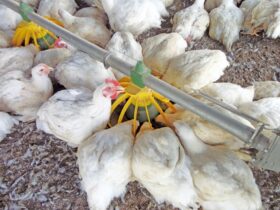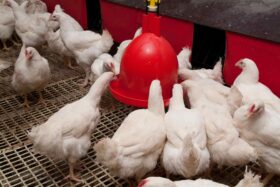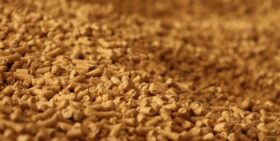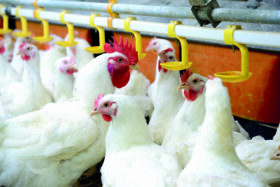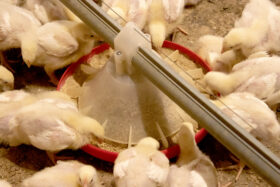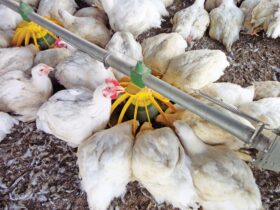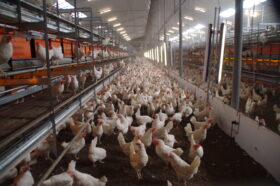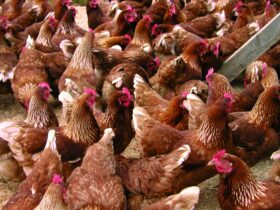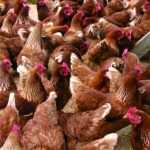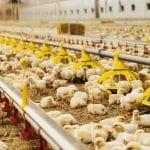Author: Ajay Bhoyar, Global Technical Manager, EW Nutrition
Exogenous feed enzymes are increasingly utilized in poultry diets to manage feed costs, mitigate the adverse effects of anti-nutritional factors, and enhance nutrient digestion and bird performance. These enzymes are primarily employed to bolster the availability of nutrients within feed ingredients. Among the various enzymes utilized, those capable of breaking down crude fiber, starch, proteins, and phytates are commonly integrated into animal production systems.
In monogastric animals such as poultry and swine, a notable deficiency exists in the endogenous synthesis of enzymes necessary for the hydrolysis of non-starch polysaccharides (NSPs) like xylan (McLoughlin et al., 2017). This deficiency often manifests in poultry production as a decline in growth performance, attributed to increased digesta viscosity arising from the prevalence of NSPs in commonly utilized poultry feed ingredients. Without sufficient endogenous enzymes to degrade xylan, NSPs can increase digesta viscosity, encase essential nutrients, and create a barrier to their effective digestion. In response to this issue, monogastric animal producers have implemented exogenous enzymes such as xylanases into the feeds for swine and poultry to degrade xylan to short-chain sugars, thus reducing intestinal viscosity and improving the digestive utilization of nutrients (Sakata et al., 1995; Aragon et al., 2018)
Understanding Xylanase Enzymes
Xylanase enzymes belong to the class of carbohydrases that specifically target complex polysaccharides, such as xylan, a backbone nonstarch polysaccharide (NSP) prevalent in plant cell walls. These enzymes catalyze the hydrolysis of xylan into smaller, more digestible fragments, such as arabino–xylo-oligosaccharides (AXOs) and xylo-oligosaccharides (XOs), thereby facilitating the breakdown of dietary fiber in poultry diets.
Mechanism of action
It is generally agreed that the beneficial effects of feed xylanase are primarily due to the reduction in viscosity. Studies have shown that supplementing xylanases to animal feeds reduces digesta viscosity and releases encapsulated nutrients, thus improving the overall feed digestibility and nutrient availability (Matthiesen et al., 2021). The reduction in digesta viscosity by adding xylanase is achieved by the partial hydrolysis of NSPs in the upper digestive tract, leading to a decrease in digesta viscosity in the small intestine (Choct & Annison, 1992).
GH10 vs. GH11 Xylanases
Well-characterized xylanases are mostly grouped into glycoside hydrolase families 10 (GH10) and 11 (GH11) based on their structural characteristics (amino acid composition), mode of xylan degradation, the similarity of catalytic domains, substrate specificities, optimal conditions, thermostability, and practical applications.
Why are GH10 xylanases more efficient in animal production?
While both GH10 and GH11 xylanases act on the xylan main chain, these two enzyme types have different folds, substrate specificities, and mechanisms of action (Biely et al., 2016). The GH10 xylanases are more beneficial in animal feed production due to their efficient mechanism of action, broader substrate specificity, and better thermostability, as discussed below.
GH10 xylanase exhibits broader substrate specificity
Generally, the GH10 xylanases exhibit broader substrate specificity and can hydrolyze various forms of xylan, including soluble and insoluble substrates. On the other hand, GH11 xylanases have a narrower substrate specificity and are primarily active on soluble xylan substrates. GH10 xylanases exhibit higher catalytic versatility and can catalyze the cleavage of the xylan backbone at the nonreducing side of substituted xylose residues, whereas GH11 enzymes require unsubstituted regions of the xylan backbone (Collins et al., 2005; Chakdar et al., 2016).
As a result, GH10 xylanases generally produce shorter xylo-oligosaccharides than members of the GH11 family (Collins et al., 2005). Moreover, as shown in Fig.1, the GH10 xylanase can rapidly and effectively break down xylan molecules.
 Fig.1.: Activity of a bacterial GH10 xylanase against soluble and insoluble arabinoxylans
Fig.1.: Activity of a bacterial GH10 xylanase against soluble and insoluble arabinoxylans
Higher thermostability
Enzymes are proteins, and the protein’s primary structure determines their thermostability. The enzyme protein tends to denature at higher than tolerable temperatures, rendering it inactive. An enzyme’s high-temperature tolerance ensures its efficacy throughout the pelleted feed manufacturing. This results in consistent enzyme activity in the finished feed, subsequent gut health, and predictable performance benefits.
Xylanases with higher thermostability are more suitable for applications requiring high-temperature processes. An intrinsically heat-stable bacterial xylanase maintains its activity even under high-temperature feed processing conditions, such as pelleting.
A study conducted at the University of Novi Sad, Serbia (Fig. 2), with three pelleting temperatures (85 °C, 90 °C, and 95 °C) and conditioning times of 4 and 6 mins, showed that Axxess XY, an intrinsically thermostable GH10 xylanase, demonstrated more than 85% recovery even at 4 to 6 mins conditioning time and 95 °C temperature.
 Fig.2: Optimum recovery of Axxess XY at elevated conditioning time and temperatures
Fig.2: Optimum recovery of Axxess XY at elevated conditioning time and temperatures
Maintaining consistently optimum enzyme activity is crucial for realizing the benefits of enzyme inclusion in feed under challenging feed processing conditions.
Conclusion
In conclusion, exogenous feed enzymes, including xylanase, have gained widespread recognition for their pivotal role in poultry nutrition. The increasing use of xylanase is attributed to its ability to effectively manage feed costs while incorporating high-fiber ingredients without compromising poultry performance. However, the efficacy of xylanase is based on several factors, including its mode of action, substrate specificity, catalytic efficacy, and thermostability. Selecting the appropriate xylanase enzyme tailored for specific needs is crucial to harnessing its full benefits.
A GH10 xylanase, such as Axxess XY, designed explicitly as a feed enzyme, offers distinct advantages in poultry production. Its efficient mechanism of action, broader substrate specificity, and superior thermostability make it a preferred choice for optimizing animal performance. Notably, Axxess XY exhibits exceptional activity against soluble and insoluble arabinoxylans, thereby enhancing nutrient utilization, promoting gut health, and ultimately elevating overall performance levels in poultry.
Incorporating specialized GH10 Xylanase enzymes like Axxess XY represents a strategic approach to unlocking the nutrients in feedstuffs, ensuring optimal performance, and maximizing profitability in the poultry business.
References
Aragon, Caio C., Ana I. Ruiz-Matute, Nieves Corzo, Rubens Monti, Jose M. Guisán, and Cesar Mateo. “Production of Xylo-Oligosaccharides (XOS) by Controlled Hydrolysis of Xylan Using Immobilized Xylanase from Aspergillus Niger with Improved Properties.” Integrative Food, Nutrition and Metabolism 5, no. 4 (2018). https://doi.org/10.15761/ifnm.1000225.
Bedford, Michael R., and Henry L. Classen. “Reduction of Intestinal Viscosity through Manipulation of Dietary Rye and Pentosanase Concentration Is Effected through Changes in the Carbohydrate Composition of the Intestinal Aqueous Phase and Results in Improved Growth Rate and Food Conversion Efficiency of Broiler Chicks.” The Journal of Nutrition 122, no. 3 (March 1992): 560–69. https://doi.org/10.1093/jn/122.3.560.
Biely, Peter, Suren Singh, and Vladimír Puchart. “Towards Enzymatic Breakdown of Complex Plant Xylan Structures: State of the Art.” Biotechnology Advances 34, no. 7 (November 2016): 1260–74. https://doi.org/10.1016/j.biotechadv.2016.09.001.
Chakdar, Hillol, Murugan Kumar, Kuppusamy Pandiyan, Arjun Singh, Karthikeyan Nanjappan, Prem Lal Kashyap, and Alok Kumar Srivastava. “Bacterial Xylanases: Biology to Biotechnology.” 3 Biotech 6, no. 2 (June 30, 2016). https://doi.org/10.1007/s13205-016-0457-z.
Choct, M., and G. Annison. “Anti‐nutritive Effect of Wheat Pentosans in Broiler Chickens: Roles of Viscosity and Gut Microflora.” British Poultry Science 33, no. 4 (September 1992): 821–34. https://doi.org/10.1080/00071669208417524.
Collins, Tony, Charles Gerday, and Georges Feller. “Xylanases, Xylanase Families and Extremophilic Xylanases.” FEMS Microbiology Reviews 29, no. 1 (January 2005): 3–23. https://doi.org/10.1016/j.femsre.2004.06.005.
Matthiesen, Connie F., Dan Pettersson, Adam Smith, Ninfa R. Pedersen, and Adam. C. Storm. “Exogenous Xylanase Improves Broiler Production Efficiency by Increasing Proximal Small Intestine Digestion of Crude Protein and Starch in Wheat-Based Diets of Various Viscosities.” Animal Feed Science and Technology 272 (February 2021): 114739. https://doi.org/10.1016/j.anifeedsci.2020.114739.
McLoughlin, Rebecca F, Bronwyn S Berthon, Megan E Jensen, Katherine J Baines, and Lisa G Wood. “Short-Chain Fatty Acids, Prebiotics, Synbiotics, and Systemic Inflammation: A Systematic Review and Meta-Analysis.” The American Journal of Clinical Nutrition 106, no. 3 (March 2017): 930–45. https://doi.org/10.3945/ajcn.117.156265.
Sakata, T., M. Adachi, M. Hashida, N. Sato, and T. Kojima. “Effect of N-Butyric Acid on Epithelial Cell Proliferation of Pig Colonic Mucosa in Short-Term Culture.” DTW – Deutsche Tierärztliche Wochenschau 102, no. 4 (1995): 163–64.
